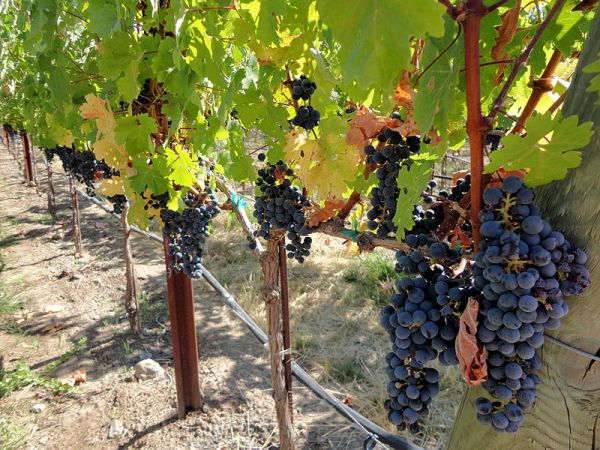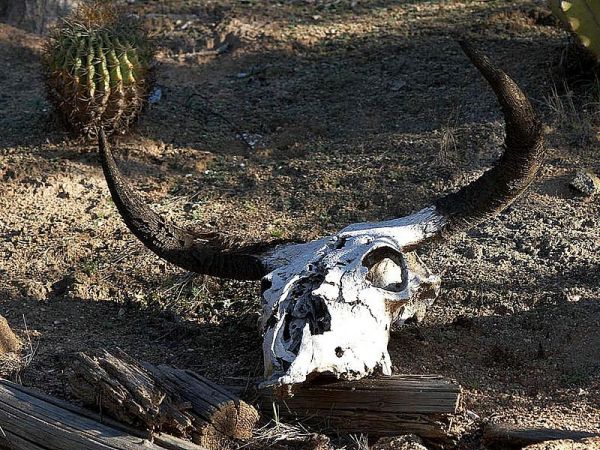Between the vine and the liquor store, plenty of secrets are submerged in your favorite bottle of vino. Here the author of Black Lane Wineries of Sonoma spills some of the best.

 2. There are also lots of cow skulls.
They’re not everywhere, but biodynamic farming techniques are on the
rise among vintners who don’t want to rely on chemicals, and this is one
trick they’ve been known to use to combat plant diseases and improve
soil PH. It’s called Preparation no. 505, and it involves taking a cow’s
skull (or a sheep’s or a goat’s), stuffing it with finely ground oak
chips, and burying it in a wet spot for a season or two before adding it
to the vineyard compost.
2. There are also lots of cow skulls.
They’re not everywhere, but biodynamic farming techniques are on the
rise among vintners who don’t want to rely on chemicals, and this is one
trick they’ve been known to use to combat plant diseases and improve
soil PH. It’s called Preparation no. 505, and it involves taking a cow’s
skull (or a sheep’s or a goat’s), stuffing it with finely ground oak
chips, and burying it in a wet spot for a season or two before adding it
to the vineyard compost. 3. Ferocious foliage is a vintners friend. The mustard flowers blooming between vineyard rows aren’t just for romance. Glucosinolates in plants like radishes and mustard give them their spicy bite, and through the wonders of organic chemistry, those glucosinolates also double as powerful pesticides. Winemakers use them to combat nematodes -tiny worms that can destroy grape crops.
4. What a canary is to a coal mine, roses are to a vineyard.
Vintners plant roses among their vines because they get sick before
anything else in the field. If there’s mildew in the air, it will infect
the roses first and give a winemaker a heads-up that it’s time to
spray.
 5. Vintners exploit the food chain.
Small birds like blackbirds and starlings can clear out 20 percent of a
crop in no time. But you know what eats little birds? Big birds.
Falconry programs are on the rise in vineyards from California to New
Zealand. Researchers have found that raptors eat a bird or two a day
(along with a proportion of field mice and other critters) and cost only
about as much to maintain as your average house cat.
5. Vintners exploit the food chain.
Small birds like blackbirds and starlings can clear out 20 percent of a
crop in no time. But you know what eats little birds? Big birds.
Falconry programs are on the rise in vineyards from California to New
Zealand. Researchers have found that raptors eat a bird or two a day
(along with a proportion of field mice and other critters) and cost only
about as much to maintain as your average house cat.
6. Wine needs cleaning. Winemaking produces hard-to-remove sediments. Filters can catch most of the debris, but winemakers must add “fining agents” to remove any suspected solids that sneak by. Until it was banned in the 1990s, many European vintners used powdered ox blood to clean their wines. Today, they use diatomaceous earth (the fossilized remains of hard-shelled algae), Isinglass (a collagen made from fish swim bladders), and sometimes bentonite (volcanic clay). Irish moss and egg whites are also fine wine cleaners.
6. Wine needs cleaning. Winemaking produces hard-to-remove sediments. Filters can catch most of the debris, but winemakers must add “fining agents” to remove any suspected solids that sneak by. Until it was banned in the 1990s, many European vintners used powdered ox blood to clean their wines. Today, they use diatomaceous earth (the fossilized remains of hard-shelled algae), Isinglass (a collagen made from fish swim bladders), and sometimes bentonite (volcanic clay). Irish moss and egg whites are also fine wine cleaners.
8. Atoms have all the answers. About 5 percent of the premium wine sold for cellaring doesn’t contain what the label promises. So how do top-shelf buyers avoid plunking down serious cash on a bottle of something bunk? Most elite wine brokerages, auction houses, and collectors use atomic dating to detect fraud. By measuring trace radioactive carbon in the wine, most bottles can be dated to within a year or two of the vintage.
9. Fine wines get MRIs. Even with atomic dating, there are certain perils involved with buying a $20,000 bottle of wine. Leaving a case in the hot trunk of your car is enough to ruin it, so imagine what can happen in a couple of decades if a wine isn’t kept in the proper conditions. Back in 2002, a chemistry professor at the University of California at Davis patented a technique that uses MRI technology to diagnose the condition of vintage wines. Not planning any $20,000 wine purchases? This is still good news for the consumer. This technique may soon be used at airport security, meaning you’ll be able to carry on your booze.
10. There’s a trick to aging your wine. If you end up with a bottle of plonk, Chinese scientists have developed a handy solution. Zapping a young wine with electricity makes it taste like something you’ve cellar aged. Scientists aren’t quite sure how it happens yet, but it seems that running your wine for precisely three minutes through an electrified field charges the esters, proteins, and aldehydes and can “age” a wine instantly.

No comments:
Post a Comment